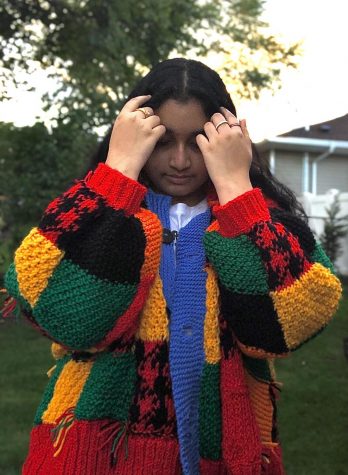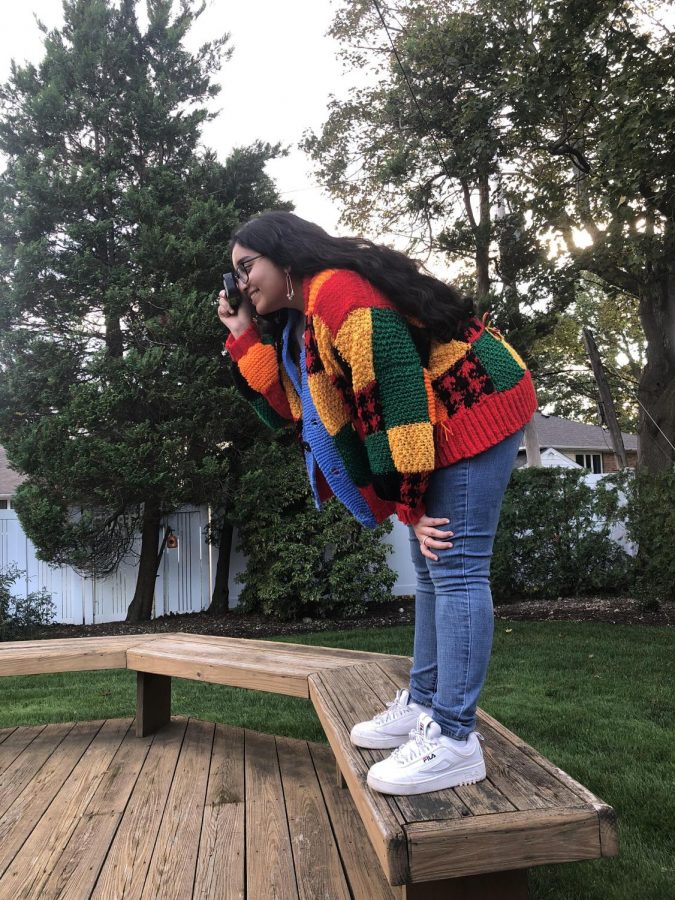Harry Styles, First Man on the Cover of Vogue
Shaira Jafar ‘21 poses in her hand-knitted JW cardigan, mimicking the pose from the Today Show Rehearsal that popularized it.
For someone whose career started in the early 2010s with boyband One Direction, Harry Styles is certainly an anomaly. He rose to fame when flower crowns and flannel shirts were popular, and became one of the most prominent fashion icons of our generation. And that’s not all. After his stint in One Direction, Styles tried acting, starring in the Christopher Nolan film Dunkirk (2017), and then returned to music. He has released two albums since One Direction disbanded in 2015; Harry Styles, released in 2017, and Fine Line, released in 2019.
Although he was already world-famous, his debut album received little attention from the general public, and only one song, Sign of the Times, got any radio play. His second album, released just over a year ago, could not be more different. Nine songs charted on the Billboard Hot 100, the album was certified Platinum by RIAA, and garnered three Grammy nominations, Styles’ first in a decade long music career. Fine Line has found success with critics, music legends, and scores of fans. It is the latest album to be added to Rolling Stone’s top 500 albums of all time and Stevie Nicks called it Styles’ ‘Rumors,’ referencing Fleetwood Mac’s legendary album in an Instagram post at the beginning of quarantine. It is not only his music that draws people to him, however, it is also his fashion.
During his One Direction days, Styles was known to wear loud patterned shirts and skinny jeans, but now he dresses like a rockstar. He wears bedazzled suits, blouses with pussy bows, and shimmering jumpsuits onstage, his flamboyance only a step under legend Elton John’s. He was the youngest MetGala co-chair in 2019, turning heads in a sheer black jumpsuit and a singular pearl earring. Offstage, his fashion is just as iconic, if a bit more toned down. He was credited with two trends this year; pearl necklaces, and a brightly colored JW Anderson Cardigan.

The cardigan blew up online, especially on TikTok, where hundreds of young fans tried to recreate it. It was so popularized that JW Anderson made the pattern and instructions available online so that any Styles fan could try to recreate it. Shaira Jafar ’21 was one of the many people who knit a version of it. When asked why she was drawn to it, she said, “The colors are bold and the knitwear is baggy. Some may deem the piece as ugly or too complex, but its uniqueness is what makes the cardigan so memorable.”
These looks, as well as the public’s obsession with buying Styles inspired clothes, landed Styles on the cover of Vogue this past December 2020, a real feat as he was the first man to appear solo on their cover. He wore many extravagant looks: hand-painted custom BODE pants, large belted jackets, and, most (in)famously, a dress.
This is not the first time that we have seen Styles dress in feminine clothing, as he often carries purses and wears blouses without any backlash. However, conservative media, specifically Candace Owens, saw the spread and immediately began bashing him. She called for people to “bring back manly men,” which resulted in large pushback from the left. “People definitely have the right to dislike Styles’ dress, but calling him ‘stupid’ for his choices in fashion is uncalled for. He should not have to wear clothing with the intent to look desirable or attractive to different people. So, it was very disappointing to see people lash out at Styles’ Vogue cover instead of supporting him,” said Jafar ’21.
Styles, however, seems unbothered by the whole ordeal, posting a photo on Instagram in a pale blue and white frilled suit jacket, eating a banana, with the caption “Bring Back Manly Men.” Clearly Styles is aware that manliness is not based on the nature of clothes that one wears, and that a man who is comfortable enough in his masculinity to wear traditionally female clothing is more manly than those that would put a man down for doing so.
“[Styles] should not have to wear clothing with the intent to look desirable or attractive to different people.” – Shaira Jafar ’21
Lucy Del Deo is an Editorial Editor for 'The Science Survey.' She grew up reading 'The New York Times' with her parents and has been inspired to pursue...
Shaira Jafar is a Copy Chief for ‘The Science Survey.' She believes that journalistic writing gives writers the ability to write about anything that...

